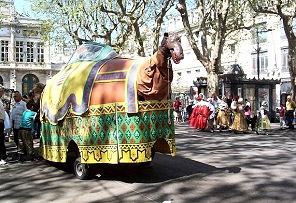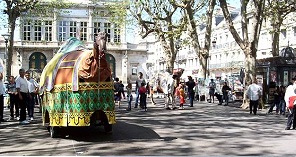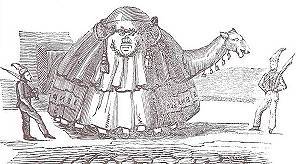THE LEGEND OF LOU CAMEL
It came from Egypt with St Aphrodise. After the death of its master, the animal risked the death soon. But a compassionate family of potters supplies it the necessary food. When Aphrodise was recognized as Saint, the city's leaders considered as an honor to take in charge all the animal maintenance's expenses. They offered it an house at the beginning of street (the current Malbec's street) and this artery, after its death, took the name of "street of the Camel". The fief's income was allocated by consuls to purchase some bread distributed to poor men (symbolized today by cakes named "coques"), once blessed by the bishop, during the Caritats' celebrations.

To immortalize the recollection an enormous wooden machine - canvas painted dressed - on which were the city's armorial bearings and two inscriptions on the sides : one in Latin EX ANTIQUITATE RENASCOR (I'm reborn from Antiquity), the second in Languedocian Occitan language : SEN FOSSO (We are a lot (strong / numerous - a cohesion's notion by the force of the number) - although "Sem Fosso" would be more judicious.
The current shape would be from the XIVth century. This machine, which did not look like a camel (rather a dromedary), had inside four persons who moved it and gave, at intervals, a jerky game to its long neck and its jaws with iron teeth. These big jaws were named "Gnico-Gnaco" in the XIXth century.
It appeared in all religious or political local celebrations, specially in those celebrated in honour of Saint Aphrodise or during the "Caritats' holidays", the Ascension day. In these different occasions, the camel was ridden by a bizarrely costumed person : the PAPARI (doubtless an alteration of the name "Papalin/Papalino" : Pope's soldier) and escorted by a group of young persons savage disguised, their head decorated with foliage and carrying a bread in balance on the head. Around the effigy, herdsmen feigned a ceaseless fight. The trades' corps followed the animal and sprayed the crowd.


The camel was burned during religious wars, reconstructed in 1632, burned again in 1793 on the Citadel's Place with all the feudal titles. The "fief of the Camel", with a 1500 pounds income allocated to its maintenance, was put under sequestration and, to seize it with an enactment of legality, the camel was put on the emigrants' list and dispossessed of its whole possessions. It was reconstructed in 1803, burned again during the 1830 Revolution. The head which escaped the disaster reappeared during the Paul Riquet statue's inauguration. Short duration return because it was again destroyed in 1848.
Once again rebuilt, it continues to run through the city's streets during local holidays.
The current head dates from the XVIII-th. In the 1970's, armature was remade by decision of the City Council.
However, the workers - in charge of the renovation - wanted to give a real camel's appearance : two bumps instead of one. But as the Biterrois protested vigorously it got again its legendary aspect.

The roots of the Camel and Caritats' celebrations could find their bases in the god Bacchus' Greek festivities (many traces of this cult can be found in the village of Agde), imported by Phoceens, where Bacchus was represented ridding a camel. Some elements of this god's cult can too be found in Béziers (Fauna's trunk).
The sentence "Sen Fosso" could so refer to viniculture : "Fosso" would got then its origin from the Latin word "fossorium", in ancient French : "fosserer", "fossoyer", nickname of a wine grower working using a "fossoir" (ancient digging tool), also indicating the vineyard's surface (4 to 5 ares) able to be dig in one day.
